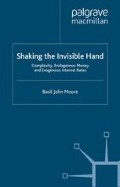Abstract
Money is the asset generally accepted as the means of payment and medium of exchange. Money also serves as a store of value and as the unit of account in which prices are expressed. The particular assets that are bestowed with general acceptability in exchange have evolved markedly over time, and are still evolving.1 For conceptual clarity it is essential to distinguish the differences between commodity, fiat, and credit money.
Perhaps the greatest moment of triumph for the elementary economics teacher is his exposition of the multiple creation of bank credit and bank deposits. Before the admiring eyes of freshmen he puts to route the practical banker who is so sure he “lends only the money depositors entrust to him.” The banker is shown to have a worm’s eye view, and his error stands as an introductory object lesson in the fallacy of composition. From the Olympian vantage of the teacher and the textbook, it appears that the banker’s dictum must be reversed; depositors entrust to bankers whatever amounts the bankers lend.
James Tobin, 1963
Monetary theory is less abstract than most economic theory, and cannot avoid relation to reality. … It belongs to monetary history in a way that economic theory does not always belong to economic history.
Sir John Hicks, 1967
The central message of this book is that members of the economics profession currently operate with a basically incorrect paradigm of the way modern banking systems operate and of the causal connection between wages, prices, and monetary phenomena. The standard paradigm treats the central bank as determining the monetary base and hence the money supply. The growth of the money supply is held to be the main force determining the rate of growth of money income, wages, and prices.… This book argues that the above order of causation should be reversed. Changes in wages and employment largely determine the demand forbank loans, which in turn determine the rate of growth of the money supply. Central banks have no alternative but to accept this course of events. Their only option is to vary the short-term rate of interest at which they supply liquidity to the banking system on demand.
B.J. Moore, 1988
Access this chapter
Tax calculation will be finalised at checkout
Purchases are for personal use only
Preview
Unable to display preview. Download preview PDF.
Copyright information
© 2006 Basil John Moore
About this chapter
Cite this chapter
Moore, B.J. (2006). The Endogeneity of Credit Money. In: Shaking the Invisible Hand. Palgrave Macmillan, London. https://doi.org/10.1057/9780230512139_9
Download citation
DOI: https://doi.org/10.1057/9780230512139_9
Publisher Name: Palgrave Macmillan, London
Print ISBN: 978-1-349-54787-6
Online ISBN: 978-0-230-51213-9
eBook Packages: Palgrave Economics & Finance CollectionEconomics and Finance (R0)

